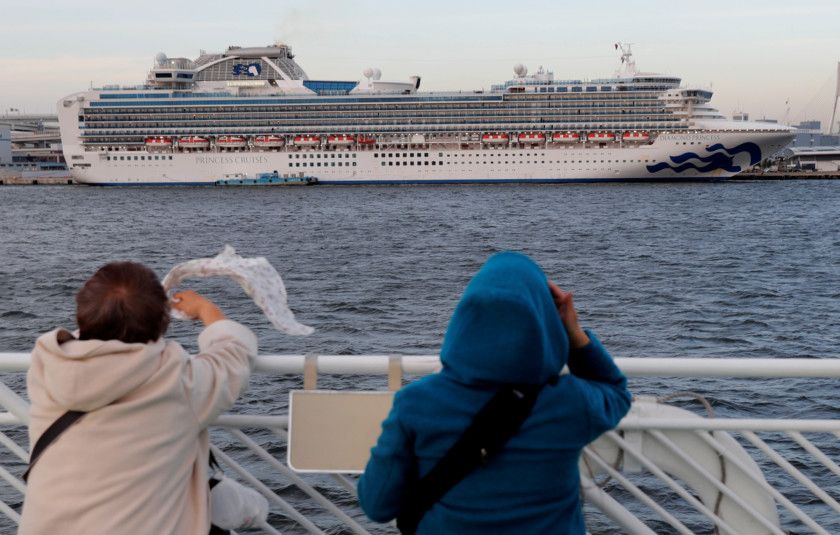Tokyo: The 3,600 people aboard the Diamond Princess, locked down for more than a week and desperate for information, have been reduced to peering out windows as hazmat-suited workers take away the newest coronavirus patients and mysterious buses, their interiors shrouded by curtains, come and go from the port.
They have Wi-Fi, but it is spotty, and even if it were not, they might search in vain for information about their plight from tight-lipped Japanese authorities.
Experts in crisis management said the government was offering a textbook example of how not to handle a public health crisis.
“Repeatedly explain what is known, and what is unknown, and when people can get more information about what remains unknown,” said Dr. Hana Hayashi, a public health strategist at McCann Healthcare Worldwide Japan. “It sounds very simple, but by continuing to do this, people’s concerns will be reduced.”
With 135 of their number known to be infected — the most cases anywhere outside China — one of the biggest questions for those stuck on the Diamond Princess off Yokohama is: Why won’t Japan test everyone on board for the virus?
As of Tuesday, only 439 had been tested, and Japanese authorities have sent mixed messages.
For days, officials have said the country simply does not have the ability to test everyone on the ship. But Tuesday, as demands grew, Dr. Masami Sakoi, an assistant health minister, said at a news briefing that the health ministry was considering expanding its testing capacity.
Japan’s insistence that it is an issue of practicality has been met with some scepticism.
Critics of the government’s handling of the outbreak say that officials simply are not explaining enough of their thinking as they face an epidemiological challenge with no easy playbook. The government’s communications strategy has undermined trust, and speculation has sometimes filled the void, including about whether there could be alternatives to keeping so many people locked inside a contaminated vessel.
“Here you have people locked down on a pseudo prison on a cruise ship,” said Kyle Cleveland, a professor of sociology at the Tokyo campus of Temple University who has studied Japan’s response to another crisis, the Fukushima nuclear meltdowns. “Is it really a matter of not having enough tests?”
In China, after all, where more than 42,000 people have been infected and deaths have surpassed 1,000, health officials are performing thousands of coronavirus tests a day. Unlike Japan, China has been confronting the outbreak since December and has had time to produce test kits. Even so, it is contending with a shortage.
Some passengers say that if it were just a matter of logistics, Japan could look for outside help.
“I’d prefer if our countries pitch in and help test everyone,” said Vera Koslova-Fu, an Australian on the ship.
Still, there is far from universal agreement that Japan should test everyone on board the Diamond Princess, even if it could.
Olivia Lawe-Davies, a spokeswoman for the World Health Organisation, said that its experts agreed with the way Japan was handling the quarantine.
“No country or entity has had to manage this novel coronavirus, for which there are still many unknowns, on an international conveyance with this many people,” she said. “The most important thing is to ensure that people who are ill receive proper treatment, which the Japanese authorities are doing.”
Some infectious disease experts questioned whether testing everyone on board would in fact be effective.
“In reality, people are in the incubation period right now,” said Mitsuyoshi Urashima, a professor of molecular epidemiology at Jikei University Hospital in Tokyo. “The tests are not absolutely always right.”
(Proof of that came from a different set of coronavirus patients Tuesday. The health ministry announced that two Japanese citizens who had previously tested negative after leaving Wuhan, China, where the epidemic began, were now infected.)
The tests themselves pose their own obstacles.
They are not simple throat swabs but instead require mucus from hard-to-reach parts of the respiratory tract.
The simplest test, a nasopharyngeal swab, “is not surgery, but it comes close,” said Dr. William Schaffner, a professor of preventive medicine and infectious diseases at Vanderbilt University Medical Centre in Nashville, Tennessee. “It’s an aggressive medical procedure.”
The alternative requires pumping saline mist deep into the lungs.
“You could not do it on healthy people by the thousands, or just go from cabin to cabin doing it,” Schaffner said.
Both procedures are risky for the medical personnel doing them because they can send the patient into a retching or coughing fit, spewing out virus.
And even then, he said, concerns would remain.
“I’m sure a lot of people on board think, ‘If I’m negative, I’m cleared,’ “ Schaffner said. “It’s not that — you could be positive tomorrow.”
Even if the tests are not scientifically warranted, some public health experts said, they might help calm anxious people on the ship.
“If it puts people’s minds at ease, it has merit,” said Eiji Kusumi, a doctor specialising in infectious diseases at Navitas Clinic in Tokyo. “We’re dealing with people who are operating out of emotion.”
One passenger, Sarah Arana, a 52-year-old medical social worker from Paso Robles, California, said, “I think it would provide peace of mind.”
Peace of mind has been hard to come by for many passengers, in no small part because of the Japanese government’s limited communications.
Passengers isolated in their cabins have been checking their phones for news updates and social media posts, while their families back home are frantically pressing for information.
By failing to hold regular and timely news briefings and doling out cryptic information, the government “has made the problem seem much larger than it looks,” said Hiromi Murakami, an expert on health policy at the National Graduate Institute for Policy Studies in Tokyo.
Rumours abound.
Early Tuesday, Japanese news outlets reported that health authorities were considering taking some elderly passengers off the ship, but officials refused to comment. Passengers on the ship could see that at least two buses, their windows covered in curtains, had pulled up to the port, and claims spread that some people were being allowed to leave.
In the absence of official communication, some have found their own way to communicate: Japanese passengers, who make up about half of the 2,666 guests on board, unfurled cloth signs off their balconies.
“Serious lack of medicine, lack of information,” read one.













